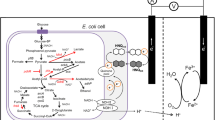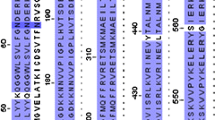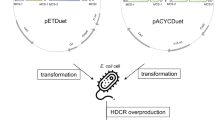Abstract
Recombinant Escherichia coli cells were applied for the recovery of electric energy from formate. Initially, the fdh gene, which encodes formate dehydrogenase (FDH) of Mycobacterium vaccae, was introduced into E. coli cells to allow efficient degradation of formate. The constructed microbial fuel cell (MFC) with E. coli BW25113 cells carrying fdh gene showed appreciable generation of current density in the presence of formate as a substrate. Current density and polarization curves revealed that the performance of MFC under examined conditions was limited by the electron transfer from bulk liquid to the electrode surface; accordingly, agitation resulted in an increase in the current density and achieved a coulombic efficiency of 21.7 % on the basis of formate consumed. Thus, gene recombination enables E. coli cells to utilize formate as a fuel for MFC.



Similar content being viewed by others
References
Kim BH, Chang IS, Gadd GM (2007) Challenges in microbial fuel development and operation. Appl Environ Microbiol 76:485–494
Pant D, Bogaert GV, Diels L, Vanbroekhoven K (2010) A review of the substrates used in microbial fuel cells (MFCs) for sustainable energy production. Bioresour Technol 101:1533–1543
Schröder U (2007) Anodic electron transfer mechanisms in microbial fuel cells and their energy efficiency. Phys Chem Chem Phys 9:2619–2629
Matsui S, Ide S, Otaki Y (1983) Roles of sulfate-reducing bacteria in organic matter decomposition and acetic acid formation by the anaerobic fluidized bed treatment. Proc Environ Sani Eng Res 19:156–162
Ha PT, Tae B, Chang IS (2008) Performance and bacterial consortium of microbial fuel cell fed with formate. Energy Fuel 22:164–168
Speers AM, Reguera G (2011) Electron donors supporting growth and electroactivity of Geobacter sulfurreducens anode biofilms. Appl Environ Microbiol 78:437–444
Potter MC (1912) Electrical effects accompanying the decomposition of organic compounds. Proc R Soc Lond Ser B 84:260–276
Liu J, Yong YC, Song H, Li CM (2012) Activation enhancement of citric acid cycle to promote bioelectrocatalytic activity of arcA knockout Escherichia coli toward high-performance microbial fuel cell. ACS Catal 2:1749–1752
Ojima Y, Suryadarma P, Tsuchida K, Taya M (2012) Accumulation of pyruvate by changing the redox status in Escherichia coli. Biotechnol Lett 34:889–893
Suryadarma P, Ojima Y, Tsuchida K, Taya M (2012) Design of Escherichia coli cell culture for regulating alanine production under aerobic conditions. J Chem Eng Jpn 45:604–608
Wakisaka T, Takada Y, Azuma M (2009) Power generation characteristics and performance improvement of a bio-fuel cell using yeast. Kouongakukaishi 35:283–290 (in Japanese)
Liu H, Logan BE (2004) Electricity generation using an air-cathode single chamber microbial fuel cell in the presence and absence of a proton exchange membrane. Environ Sci Technol 38:4040–4046
Qiao Y, Bao SJ, Li CM, Cui XQ, Lu ZS, Guo J (2008) Nanostructured polyaniline/titanium dioxide composite anode for microbial fuel cells. ACS Nano 2:113–119
Sakai H, Nakagawa T, Tokita Y, Hatazawa T, Ikeda T, Tsujimura S, Kano K (2009) A high-power glucose/oxygen biofuel cell operating under quiescent conditions. Energy Environ Sci 2:133–138
Nimje VR, Chen C-Y, Chen C-C, Chen H-R, Tseng M-J, Jean J-S, Chang Y-S (2011) Glycerol degradation in single-chamber microbial fuel cells. Bioresour Technol 102:2629–2634
Acknowledgments
This study was supported in part by Kansai Research Foundation for Technology Promotion. This study was also founded by the Sumitomo Foundation. We thank Dr. Kurihara of Kyoto University for kindly providing the pFDHADH plasmid.
Author information
Authors and Affiliations
Corresponding author
Rights and permissions
About this article
Cite this article
Ojima, Y., Kawata, T., Matsuo, N. et al. Recovery of electric energy from formate by using a recombinant strain of Escherichia coli . Bioprocess Biosyst Eng 37, 2005–2008 (2014). https://doi.org/10.1007/s00449-014-1179-4
Received:
Accepted:
Published:
Issue Date:
DOI: https://doi.org/10.1007/s00449-014-1179-4




